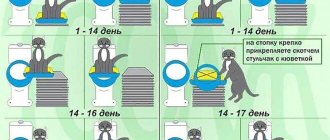Features of training an adult cat
Adult cats, unlike little fluffy cats, have an already established nervous system. They have developed the skills they need for life and actively use them for certain purposes. Therefore, you should not feed yourself hopes that the animal will quickly understand where the toilet is and will go there. Before training an adult cat to use a litter box, you need to be patient and take time.
First, keep in mind that an adult animal already has its own established character. Therefore, in the process of training a cat to use a litter box, it is also important to take into account its characteristics. Most often, problems occur in furry cats who previously lived on the street. As a rule, they can consider any space hidden from prying eyes to be a toilet.
Do you want to know how to train a cat to use a litter box in a new home? It is enough to do the following:
- Limit your pet's movement. For a while, do your best to keep your cat in one specific room. Place bowls with food and water there, and a tray as far as possible from them (cats are clean animals that will not relieve themselves near food).
- Try to control the cat's movements and monitor its behavior. As soon as you notice that the purr is looking for the toilet, bring him to the tray.
- Under no circumstances should you place the litter box in the middle of the room. It is necessary to choose the right place for the cat litter. Remember that it should be comfortable not only for you, but for your pet. Most cats do not like the litter box to be in a visible place. Therefore, it is better to place it in the corner of the room.
- If you notice that your cat goes to the toilet not in the litter box, but in the same place in the house, place the potty there. Over time, when the animal gets used to the toilet with filler, simply move the tray to any place convenient for you.
We teach a kitten from scratch to go to the litter box without litter
If you are thinking of immediately accustoming your kitten to a litter box without litter, then first of all, be patient. You cannot hit your pet, this will only ruin his psyche and cause rejection of the training process itself. In addition, cats are quite smart animals and oral instruction will be enough (of course, they will not understand speech, but they will understand intonations). You can cover all your favorite areas with oilcloth paper to avoid problems if your cat gets used to going where it shouldn’t.
Tray training an outdoor cat
How to accustom a kitten to dry food
Action plan for weaning a cat from climbing into a flower pot
Tip #1. Drag the tray to the desired location
If the kitten has chosen a certain place, then it is better to move the tray there. Then you need to gradually move the potty to the required corner and room, moving the toilet every day 10 cm closer to the point where it should be located according to plan.
Tip #2. Praise and Progression
It is necessary to divide the entire apartment into certain zones according to the degree of distance from the place where the tray is located and the points where the animal defecates. Let's say there are 5 such areas. You also need to distribute your attitude (praise, neutrality, punishment) into three zones. Then gradually move your attitude, as shown in the figure below.
That is, at first you scold the kitten for defecating in the living room, but be neutral if he defecates in the corridor on the way out of the room. Then you begin to scold him not only for feces in the room, but also for crossing, leaving him only a place in the bathroom. And in the end you begin to scold for defecation in any place other than the tray. Relationships are highlighted in colors: red - punishment, yellow - neutrality, green - praise.
Tip #3. Lock it in a separate room
Set up a prison for the animal. Lock him in his room for a week. Place plates with food and water in one corner, and a pot in the other. The tray must be changed several times a day. You will be left with no choice - either the pet will defecate wherever it wants and suffer from the smell, or it will learn to use the toilet. Of course, you must first remove all carpets, as well as upholstered furniture: sofas, armchairs, beds. It is also advisable to remove flowers and any potted plants.
Tip #4. Monitor and carry the cat when it urges
This method will require attention from the owner. Its essence is that you need to guess the moments when the pet goes to the toilet. And when the urge arises, transfer it to the tray. If everything goes well and the kitten goes into the litter box, then you will need to praise him and give him a treat. The disadvantage of this method is that cats can go to the toilet at night, so the owner will still not be able to track all the moments of defecation.
Tip #5. Use of aerosols
When you can’t train your pet, you need to use special aerosols:
1. "Antigadin". A low-cost Russian product that does not stain and has a natural composition. But the possibility of allergies cannot be ruled out. However, some people note the lack of effectiveness, short shelf life, and the smell of dichlorvos, which is strong enough to repel not only cats, but also people.
2. "Smart spray". Domestic product based on natural ingredients. You need to spray the tray with this spray, after which the cat should become interested in the aroma and start going to this place. Absolutely all users note a terrible smell from the aerosol, so it is better not to approach the tray after use. About a third of clients indicate the low effectiveness of the product.
3. "Stop spray." The spray is produced in the Netherlands and does not cause allergies. Its task is to scare the animal away from the places where it is accustomed to defecate with an unpleasant odor. This is one of the few products that has an attractive aroma for humans, but an unbearable odor for animals. The product holds well, but is easily overwhelmed by other odors, so about a third of customers indicated low effectiveness.
All these aerosols must be used over a long period of time to achieve results. Moreover, after you stop using aerosols, your pet can begin to defecate in any place convenient for him.
The main thing here is a calm attitude towards the learning process. You should not hit or seriously punish your pet, this can scare away and slow down the development of the skill. First you need to choose a suitable tray. You need to gradually get used to using a tray without filler.
How to choose a tray and filler
Before you begin toilet training an adult cat, you need to take care of choosing the right tray and filler for it. Currently, there are several variations of tray designs. And, if in the case of a small kitten, you can simply accustom your pet to a certain type of toilet, then with an adult animal you need to try a wide variety of options, choosing exactly the one that suits the fluffy one.
Tip : If you got a cat that lived with other people for a long time, ask the previous owners what kind of toilet they used for the animal. Find out more about the type of potty and litter your purr is used to.
When choosing a tray, special attention should be paid to its size. Keep in mind that an adult cat needs space to bury all of its waste. Therefore, small pots may simply be ignored by the animal.
Also pay attention to the height of the sides. By choosing high tray walls, you prevent the filler from appearing on the floor in the room. This greatly simplifies the cleaning process. However, for small purrs, high sides can become an obstacle and slow down the process of accustoming the cat to the tray.
The most popular designs of trays today are plastic products with a side height of 10 cm or more. They will allow you to save the maximum amount of filler inside the pot while the cat is burying waste and are convenient for fluffies of any size.
Now let's talk about litter, which, no matter how strange it may sound, is an important factor in quickly toilet training a cat. Today, on store shelves you can find a wide variety of fillers: clay, silica gel, wood, etc. Determining which one is suitable specifically for your animal can only be done experimentally. Experiment by purchasing this or that option and be sure to monitor your pet’s reaction.
If you pick up an adult cat from the street, we recommend that you pay attention to wood or clay litter. Both of these options are environmentally friendly and lack strong artificial odors. Street purrs will associate such fillers with wild nature, which will help quickly accustom the cat to the toilet.
How to train a cat to use a litter box
When an adult purr comes to your home and is already accustomed to independence, it is important to think through the organization of the territory in detail. It is necessary to determine the place where the bowl of food and water will be, where the purr's bedroom will be, and, of course, it is important to think about the location of the toilet.
Some adult outdoor cats, at a certain point, begin to intuitively understand why there is a tray in the room. In this case, taming the animal to the toilet will be much faster. In addition, it is important to remember that furry cats are very sensitive to changes in a person’s voice. Therefore, if you notice that the cat went to the toilet in the wrong place, just change the intonation. Any physical punishment will cause fear in the pet and provoke it to search for a more secluded place for the toilet.
At the same time, remember to praise your cat every time he uses the litter box. This technique acts as positive reinforcement and significantly speeds up the process of training your cat to use the litter box.
Now let's talk about how to train an adult cat to go to the litter box. It is important to follow the sequence of actions here:
- Show the purr where the tray is and watch its actions. As a rule, cats begin to look for the toilet 1-2 hours after eating. This is immediately reflected in their actions. The animals begin to rush around the room in search of a secluded place. This behavior should become familiar to you. Take your cat and put him in his litter box.
- If he relieves himself in the right place, be sure to praise him. If not, you should not rush and scream at your pet. Wipe up the puddle or collect the poop in a tissue. Place it in the tray. This way, next time the animal will be able to determine by smell where to go to the toilet.
- You need to quickly get rid of the unpleasant odor. To do this, use strong-smelling detergents or a special spray that can be bought at any veterinary store. More natural remedies include mixing water, vinegar and vodka, or a small amount of water with lemon or orange essential oil. Such mixtures can kill unpleasant odors and discourage the cat from the wrong place.
- As you already understand, cats do not like the strong pungent smell of household chemicals (washing powders, detergents). However, for some reason, we just love the smell of outdoor shoes. Therefore, if you want to quickly train your cat to use the litter box, I recommend that you put your boots and shoes in the closet. They can provoke the fluffy to mark the territory.
Retraining a kitten to use a litter box without litter
First of all, there is no need to rush. After the kitten has mastered the litter box, 2-3 months must pass for the habit to finally take hold, and for the litter tray to become saturated with the smell and attract the animal. Of course, all this time the bedding must be regularly updated and the tray cleaned.
The easiest way to accustom a kitten to a litter box without litter is to gradually reduce the amount of litter. Every week you need to reduce its weight by 150-200 grams. Of course, the pet will be uncomfortable because digging in the toilet is becoming more and more difficult.
If at some point he begins to defecate in the wrong places, then you need to temporarily increase the amount of filler and stop to consolidate the result, and then continue the procedure of reducing the mass of the filler.
In this case, it is necessary to update the filler more often. Over time, when you get rid of the litter in the tray completely, you will need to quickly clean up after the animal immediately and every time after he goes to the toilet.
How to stop an adult cat from shitting?
If you've tried all of the above methods for litter box training an outdoor cat, but none of them worked, don't despair.
First, try to rule out any health problems in your pets. Be sure to take your cat to the vet for a checkup. An experienced doctor will help identify inflammatory processes in the urinary or reproductive system. This is especially true in the cold season.
As a result of successful treatment of such diseases, the problem of toilet training a cat will be solved by itself.
Also read: How to stop a cat from shitting anywhere?
Tools for litter training
How to quickly train a cat to use the litter box? Of course, first of all it is necessary to comply with all the above steps. However, if you want to significantly speed up the process, you can use special tools. In any veterinary store today you can buy various sprays that either stimulate the animal to relieve itself in a certain place, or have a repellent odor, for treating areas marked by the pet in the house. Before using repellents, you must thoroughly wash all areas marked by the purr using any detergent containing bleach.
Sprays that encourage the cat to go to the toilet in a certain place deserve special attention. They can be used for both small and adult pets. Experts recommend spraying the area near the tray with a spray two to three times a day to achieve faster results. Of course, over time (if the result is positive) you can reduce the number of sprays.
However, even if you notice that your pet regularly goes to the toilet in the litter box, you must continue to use the spray for 7-10 days. Only after the cat has established the habit of going to the litter box can you stop using aids.
Also read: How to determine the breed of a cat?
Well, I hope we have given a comprehensive answer to the question of how to train an adult cat to use the litter box. Remember that street cats that have lived outdoors for several years, or purrs that have previously been with other owners, have a hard time with a change of environment and are not always amenable to training the first time. Therefore, we recommend that you be patient and not give up if you fail. Over time, the cat will get used to the place with the tray and will stop marking territory in other unauthorized corners of the house.
Algorithm for potty training a kitten
If you want to toilet train your pet, you can use the following algorithm:
- To begin, choose a location for the tray;
- After sleeping or eating, take the kitten to the litter box. The animal’s body is designed in such a way that after eating, the pet begins to want to go to the toilet;
- Hold the kitten carefully. If he starts rowing with his paw on his own, show him that this can be done in the tray;
- If your pet relieves itself, be sure to praise it. At the same time, speak in a gentle tone;
- Even if the baby did things correctly, it does not mean that he remembered and understood where to go to the toilet. You can train your pet using another method. When your pet makes a puddle in the wrong place with a napkin, blot it with a napkin and then put it in the tray;
- To wean a kitten from going to the toilet in the wrong place, you need to carefully treat the puddle. For this, there are special products that remove odor and enzymes;
- Next time, if a similar situation happens, take the baby to the tray without unnecessary screaming. By the smell, he will understand that he needs to relieve himself there. Be sure to praise the animal;
- You can use special means that attract the kitten to the tray;
- When you are litter training your pet, it is important to choose the right cat litter. But the key to success will be its correct use.
When choosing litter for the toilet, make sure that the cat gets used to it in stages. To do this, you can first lay the diaper with which you wiped the puddle on the bottom. This way you will not only preserve the smell, but will also be able to gradually accustom the kitten. Then take the filler and gradually, every day, add it to the tray. At first you can place it in one corner. After the kitten can go to the toilet, the next day, add the product in another corner. This method of training may take about a week. Gradually, as you add litter to the tray, you will notice that the kitten begins to rake it in. This is how a natural reflex works.
Sometimes the opposite happens - the kitten may not like the toilet product. In order not to make a mistake with your choice, we recommend that you do not buy a large pack at once. We hope that knowing all the nuances will help you teach your pet to use the potty.











